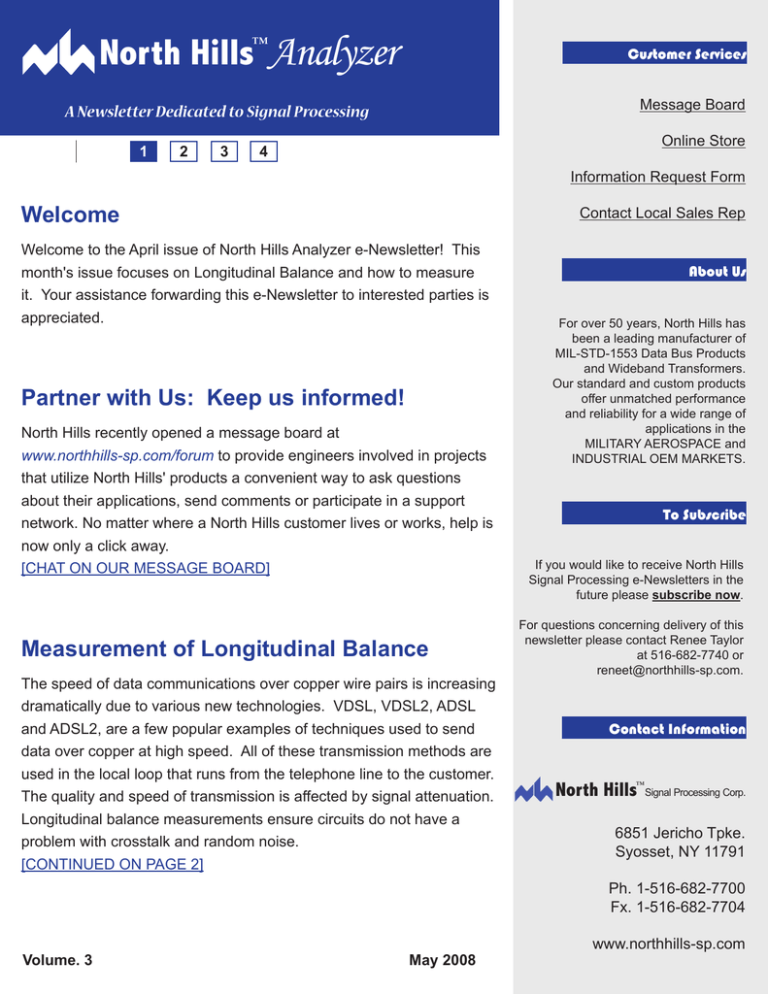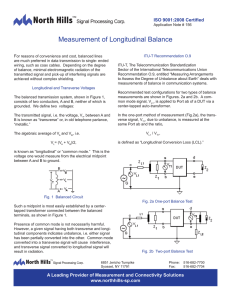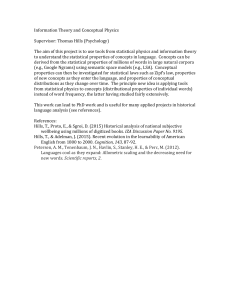Volume 3. Measurement of Longitudinal Balance
advertisement

North Hills™Analyzer Customer Services Message Board A Newsletter Dedicated to Signal Processing 1 2 3 Online Store 4 Information Request Form Welcome Contact Local Sales Rep Welcome to the April issue of North Hills Analyzer e-Newsletter! This month's issue focuses on Longitudinal Balance and how to measure it. Your assistance forwarding this e-Newsletter to interested parties is appreciated. Partner with Us: Keep us informed! North Hills recently opened a message board at www.northhills-sp.com/forum to provide engineers involved in projects that utilize North Hills' products a convenient way to ask questions about their applications, send comments or participate in a support network. No matter where a North Hills customer lives or works, help is now only a click away. [CHAT ON OUR MESSAGE BOARD] Measurement of Longitudinal Balance The speed of data communications over copper wire pairs is increasing dramatically due to various new technologies. VDSL, VDSL2, ADSL and ADSL2, are a few popular examples of techniques used to send data over copper at high speed. All of these transmission methods are used in the local loop that runs from the telephone line to the customer. The quality and speed of transmission is affected by signal attenuation. Longitudinal balance measurements ensure circuits do not have a problem with crosstalk and random noise. [CONTINUED ON PAGE 2] About Us For over 50 years, North Hills has been a leading manufacturer of MIL-STD-1553 Data Bus Products and Wideband ­Transformers. Our standard and custom products offer unmatched performance and reliability for a wide range of ­applications in the MILITARY AEROSPACE and INDUSTRIAL OEM MARKETS. To Subscribe If you would like to receive North Hills Signal Processing e-Newsletters in the future please subscribe now. For questions concerning delivery of this newsletter please contact Renee Taylor at 516-682-7740 or reneet@northhills-sp.com. Contact Information North Hills™Signal Processing Corp. 6851 Jericho Tpke. Syosset, NY 11791 Ph. 1-516-682-7700 Fx. 1-516-682-7704 Volume. 3 May 2008 www.northhills-sp.com North Hills™Analyzer 1 2 3 4 Measurement of Longitudinal Balance Why Measure Longitudinal Balance? Balanced lines, such as UTP – unshielded twisted pair – have become the preferred medium for data transmission. They offer an inexpensive solution to assure reliable data transmission by minimizing radiation and pickup of interfering signals. The degree of balance of these lines is, therefore, an important parameter. How do You Measure Longitudinal Balance? In connection with the balanced lines A and B, shown in Fig.1, we define two signals. which is the transmitted data signal. In a perfectly balanced system the impedances from either balanced line terminal to ground are equal, so that an applied transverse signal does not produce a longitudinal component. ITU-T Recommendation O.9 deals with measurements of balance in communication Systems. ITU-T is the Standardization Sector of the International Telecommunications Union. Given the two-port balanced system of Fig. 2, The Recommendation defines a number of balance to ground measurements: Longitudinal Conversion Loss (LCL) = VL1 / VT1 Longitudinal Conversion Transfer Loss (LTCL) = VL1 / VT2 Transverse Conversion Transfer Loss (TCTL) = VT1 / VL2 Fig. 1. Balanced Lines AB The longitudinal or “common mode” signal VL = (VA + VB) / 2 i.e., the voltage between the electrical midpoint of the balanced line and ground, and the transverse signal VT = VAB = VA – VB the voltage between the parallel line terminals, Fig. 2. Two-Port Balanced System LCL is also known as the one-port and LCTL as the two-port longitudinal balance measurement. The measurements are all expressed in dB, i.e. as 20log of the voltage ratio. Fig. 3 Illustrates the measurement of LCL and LTCL using a network analyzer and a longitudinal balance bridge. The balance bridge includes all the elements specified in Recommendation O.9 Ph. 1.516.682.7700 North Hills ™ Signal Processing Corp. 2 North Hills™Analyzer 1 2 3 4 Measurement of Longitudinal Balance (Continued from page 2) including a balanced-to-unbalanced transformer with very high inherent balance to ground. Note: The LCTL measurement requires an additional common mode injection circuit. Links to Relevant Data Sheets: LBB Series Longitudinal Balance Bridges 800 MHz Longitudinal Balance Bridge CMI Series of Common Mode Injectors Links to Relevant Application Notes: LCL (One-Port) LCTL (Two-Port) Fig. 3. Longitudinal Balance Measurement Conclusion In order to deliver reliable broadband services, it is very important to invest in improving the network infrastructure. In order to minimize crosstalk and other types of signal attenuation, longitudinal measurements are vital. The investment in these measurements helps reduce customer complaints and service calls. North Hills offers a complete line of longitudinal balance bridges for both 50 and 75Ω network analyzers. App. Note 156. Measurement of Longitudinal Balance App. Note 162. Testing VDSL Network End Service Splitters App. Note 163. Testing VDSL Remote Customer End Service Splitters App. Note 164. LBB Series One-Port Calibration Procedure App. Note 165. LBB Series Two-Port Calibration Procedure For more information on North Hills’ extensive line please visit: http://www.northhills-sp.com/products-wideband.html The LBB Series covers impedances from 100 to 150Ω over the frequency range from 10kHz to 800MHz. The CMI Series are common mode injectors for two-port measurements complementing the LBB Series. The North Hills LBB Series Longitudinal Bridge ships with its own test termination and storage case. Patent# US 7,282,903 B2 www.northhills-sp.com 3 North Hills™Signal Processing Corp. North Hills™Analyzer 1 2 3 4 For questions concerning delivery of this newsletter, please contact Renee Taylor at: North Hills Signal Processing 6851 Jericho Tpke, Syosset, NY 11791 Phone: 1-516-682-7740; Fax: 1-516-682-7704 Email: reneet@northhills-sp.com Web: www.northhills-sp.com www.northhills-sp.com 4 North Hills™Signal Processing Corp.



